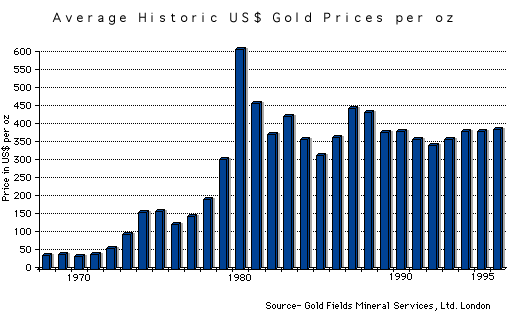
 Home
HomeGold
It is estimated that all the gold in the world, so far refined, could be placed in a single cube 60 ft. on a side. Of all the elements, gold in its pure state is undoubtedly the most beautiful. It is metallic, having a yellow color when in a mass, but when finely divided it may be black, ruby, or purple. It is a soft metal and is usually alloyed (mixed with other metals) to give it more strength.
History
Known and highly valued from earliest times, gold is found in nature as the free metal and in tellurides; it is very widely distributed and is almost always associated with quartz or pyrite (iron pyrite is called 'Fool's Gold').
Sources
About two thirds of the world's gold output comes from South Africa, and about two thirds of the total U.S. production comes from South Dakota and Nevada. Gold occurs in seawater to the extent of one-tenth milligram to two milligrams per ton, depending on the location where the sample is taken.
Properties
Resistance to Corrosion:
Gold is the most non-reactive of all metals -- it is benign in all natural and industrial environments. Gold never reacts with oxygen, which means it will not rust or tarnish.
Electrical Conductivity:
It is a good conductor of heat and electricity, and is unaffected by air and most reagents. Gold is among the most electrically conductive of all metals. Since electricity is basically the flow of charged particles in a current, metals that are conductive allow this current to flow unimpeded. Gold is able to convey even a tiny electrical current in temperatures varying from -55° to +200° centigrade.
Ductility And Malleability:
Gold is the most ductile of all metals, allowing it to be drawn out into tiny wires or threads without breaking. A single ounce of gold can be drawn into a wire five miles long. It can be shaped or extended into extraordinarily thin sheets. For example, one ounce of gold can be hammered into a 100 square foot sheet.
Infrared (Heat) Reflectivity:
Gold is the most reflective and least absorptive material of infrared (or heat) energy. High purity gold reflects up to 99% of infrared rays.
Thermal Conductivity:
Gold is also an excellent conductor of thermal energy or heat. Since many electronic processes create heat, gold is necessary to transfer heat away from delicate instruments. For example, a 35% gold alloy is used in the main engine nozzle of the Space Shuttle, where temperatures can reach 3300° centigrade. Gold alloy is the most tenacious and long-performing material available for protection of these temperatures.
Uses
It is used in coinage and is a standard for monetary systems in many countries. It is also extensively used for jewelry, decoration, dental work, and for plating. It is used for coating certain space satellites, as it is a good reflector of infrared and is inert.
Measuring
Gold, like other precious metals, is measured in troy weight; when alloyed (mixed) with other metals, the term carat is used to express the amount of gold present, 24 carats being pure gold.
Value 
Chemical Compounds
The most common gold compound is chlorauric acid used in photography for toning the silver image. Another isotope is used for treating cancer and other diseases. Disodium aurothiomalate is administered intramuscularly as a treatment for arthritis.
For many years the temperature assigned to the freezing point of gold has been 1063.0C; this has served as a calibration point for the International Temperature Scales and the International Practical Temperature Scale. In 1968, a new International Practical Temperature Scale was adopted, which demands that the freezing point of gold be changed to 1064.43C. The specific gravity of gold has been found to vary considerably depending on temperature, how the metal is precipitated, and cold-worked.